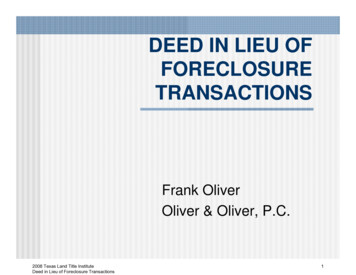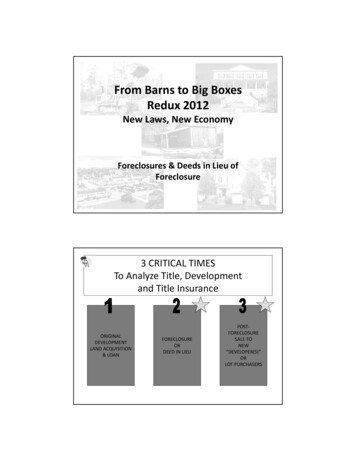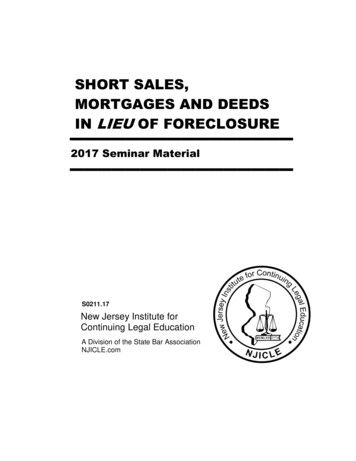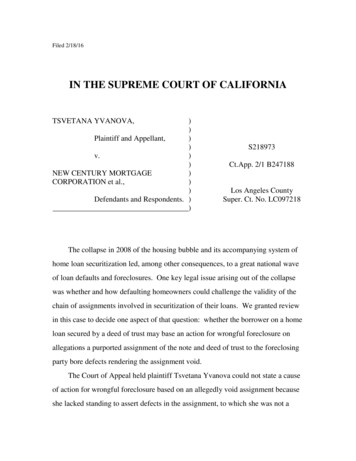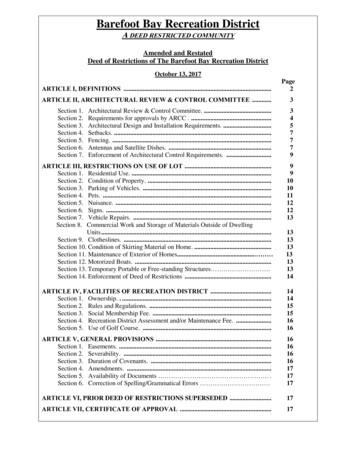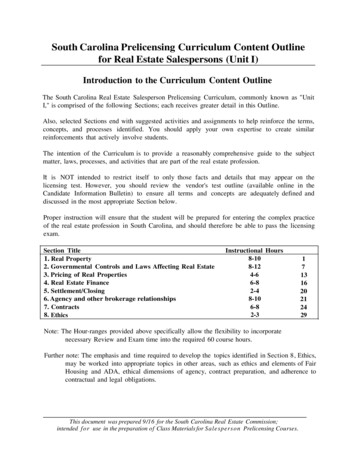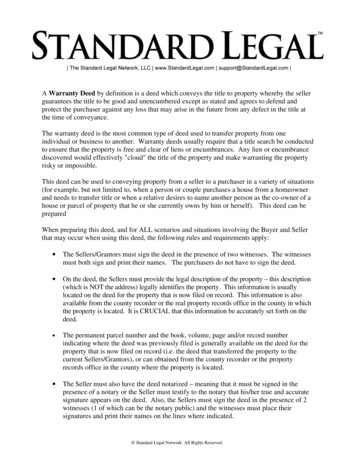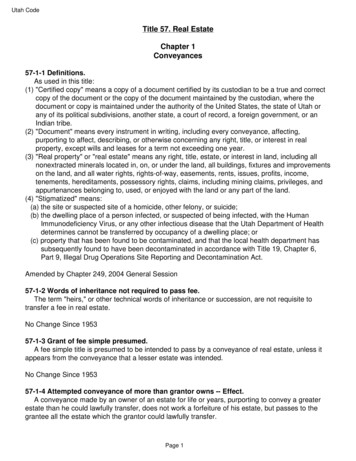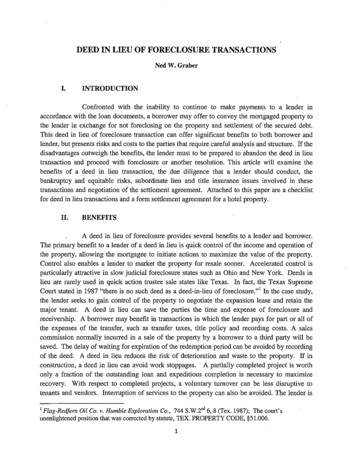
Transcription
DEED IN LIEU OF FORECLOSURE TRANSACTIONSNed W. GraberI.INTRODUCTIONConfronted with the inability to continue to make payments to a lender inaccordance with the loan documents, a borrower may offer to convey the mortgaged property tothe lender in exchange for not foreclosing on the property and settlement of the secured debt.This deed in lieu of foreclosure transaction can offer significant benefits to both borrower andlender, but presents risks and costs to the parties that require careful analysis and structure. If thedisadvantages outweigh the benefits, the lender must to be prepared to abandon the deed in lieutransaction and proceed with foreclosure or another resolution. This article will examine thebenefits of a deed in lieu transaction, the due diligence that a lender should conduct, thebankruptcy and equitable risks, subordinate lien and title insurance issues involved in thesetransactions and negotiation of the settlement agreement. Attached to this paper are a checklistfor deed in lieu transactions and a form settlement agreement for a hotel property.II.BENEFITSA deed in lieu of foreclosure provides several benefits to a lender and borrower.The primary benefit to a lender of a deed in lieu is quick control of the income and operation ofthe property, allowing the mortgagee to initiate actions to maximize the value of the property.Control also enables a lender to market the property for resale sooner. Accelerated control isparticularly attractive in slow judicial foreclosure states such as Ohio and New York. Deeds inlieu are rarely used in quick action trustee sale states like Texas. In fact, the Texas SupremeCourt stated in 1987 "there is no such deed as a deed-in-lieu of foreclosure."! In the case study,the lender seeks to gain control of the property to negotiate the expansion lease and retain themajor tenant. A deed in lieu can save the parties the time and expense of foreclosure andreceivership. A borrower may benefit in transactions in which the lender pays for part or all ofthe expenses of the transfer, such as transfer taxes, title policy and recording costs. A salescommission normally incurred in a sale of the property by a borrower to a third party will besaved. The delay of waiting for expiration of the redemption period can be avoided by recordingof the deed. A deed in lieu reduces the risk of deterioration and waste to the property. If inconstruction, a deed in lieu can avoid work stoppages. A partially completed project is worthonly a fraction of the outstanding loan and expeditious completion is necessary to maximizerecovery. With respect to completed projects, a voluntary turnover can be less disruptive totenants and vendors. Interruption of services to the property can also be avoided. The lender is1 Flag-Redfern Oil Co. v. Humble Exploration Co., 744 S.W.2nd 6, 8 (Tex. 1987); The court'sunenlightened position that was corrected by statute, TEX. PROPERTY CODE, §51.006.1
able to capitalize on the borrower's cooperation and obtain better and more complete informationabout the property. Not only is the borrower more willing to operate the property throughclosing in accordance with the lender's standards, but borrowers will often agree to deliver moreinformation and original documents regarding the property. Other covenants and warranties maybe negotiated in the settlement agreement. As with any other workout, a settlement agreement isan opportunity to correct deficiencies in loan documentation. The lender may be able to avoidthe risk of delay of a filing of a petition in bankruptcy. The filing of a deed in lieu is privatetransaction. The stigma of a foreclosure for the property and adverse credit rating can be avoidedfor the borrower. If the lender takes title in a subsidiary, it avoids the publicity and notoriety of apublic sale. A quick closing can end the borrower's responsibility for payment of propertyexpenses, insurance and property taxes. The parties can reach a final settlement of theirliabilities under the loan documents. The borrower and guarantors can be released from claimsfor deficiency and carve-out liabilities and the lender can receive a release from any lenderliability claims.III.DUE DILIGENCEA.Property Review. A deed in lieu of foreclosure is an acquisition of title toreal property and should be approached with the same due diligence and scrutiny of the purchaseof any other property. A lender needs to understand all the obligations and responsibilities ofownership of the property. At a minimum, operating statements and books and records for theproperty should obtained and reviewed to understand the revenues, payables, capitalexpenditures, and security and utility deposits. The lender should review all contracts and otheragreements relating to the property, including management contracts, brokerage agreements,equipment leases· and service contracts, and determine whether the contracts are assignable andwhether to continue or terminate them upon closing. Replacement agreements may be needed inthe event of any terminations. The lender may want to obtain estoppels from certain vendors andcounterparties. For example, if the title to the property is held under a ground lease, the lenderwill want a current estoppel certificate from the ground lessor. A current rent roll and all leasesand lease guaranties should be obtain and review to determine the obligations of the landlord andtenants, and confirm that that the tenants are required to attorn to a successor owner. It may benecessary to obtain subordination, non-disturbance and attornment agreements from sometenants and estoppels should be obtained from all tenants. If not already in its files, the lendershould obtain copies of and review all permits, certificates of occupancy and other approvals forthe property, plans and specifications, warranties, and insurance policies. The adequacy of theinsurance policies should be assessed, payment of premiums confirmed, and a determinationmade whether to continue the policies or place new insurance at closing. The property should beinspected to determine its condition, identify needed repairs and unsafe conditions andconditions of non-compliance with applicable handicap access or other laws and regulations.Public records should be searched for any outstanding violations and whether the property2
complies with existing zoning, land use and other laws and regulations. The lender shoulddetermine whether all property, gross receipt, income, sales, withholding and payroll taxes havebeen paid by the borrower. The lender should discover the status of any pending tax protests.The lender should also conduct searches for any pending litigation or claims against the propertyor borrower.Environmental. The lender must obtain an updated Phase I environmentalreport on the property. A mortgage lender acquiring title to a property by either a deed in lieu offoreclosure or by foreclosure may become an "owner or operator" with strict liability for futurecosts and expenses of remediation of hazardous substances under federal or state environmentallaws unless the lender can prove it qualifies as a "bona fide prospective purchaser." This defenserequires the owner to show that prior to purchasing or acquiring title to the property, it conductedall appropriate inquiry of the previous ownership and uses of the property consistent with goodcommercial or customary practices. 2 Thus, the lender cannot rely upon the old environmentalreport delivered at the time of the loan closing. This defense imposes continuing obligationsupon the owner during its period of ownership regarding known contaminants. In some cases,the inquiry may lead the lender to conclude that it does not want to accept a deed to the propertyor foreclose on the property, and the lender may want to reconsider accepting a discountedpayoff or a discounted sale of the mortgage loan.A lender should not accept a deed to the property unless it is confident that thecost of the clean-up is small. It has been suggested that a lender might accept title to acontaminated property in an entity controlled by the lender, but the lender may find that it isunable to resell the property to another purchaser without paying or indemnifying the purchaserfor the costs of remediation. A lender may face the risk of an third party or the governmentpiercing the corporate veil of the controlled entity to seek recovery directly from the lender.Moreover, a lender should determine whether the protection of secured lender exemptions extendto the controlled entity of the lender accepting a deed in lieu of foreclosure.Several states have adopted their own environmental liability schemes, such asResponsibility Transfer Acts which require the recording of environmental disclosure statementsupon the recording of property transfer. Some of these states require the assumption of theresponsibility to remediate known environmental conditions and permit any party to thetransaction to void the transaction for non-compliance. The lender should determine whether anyapplicable state statutes require compliance or exempt a deed in lieu of foreclosure. 3B.240 C.P.R. §312 (2010); ASTM EI527-05; In addition, the "secured creditor" exemption can provideexemption from the status of an owner or operator even where the lender has taken title throughforeclosure (including a deed in lieu), 42 U.S.C. A. §9601(20) (2010); See TEX. WATER CODE§26.3514(D) (Vernon 2010) dealing with storage tanks.3 Indiana Responsible Party Transfer Act, IC 13-25.3; The Connecticut Transfer Act C.O.S.A. 22a134(1)(C) exempts a transferee of a deed in lieu of foreclosure, as defined in and that qualifies for thesecured lender exemption pursuant to §22a-452f(b).3
C.Title Search. A lender must obtain title and UCC financing searches ofthe property to identify all matters and liens affecting the property. Unlike a foreclosure, avoluntary transfer of the property pursuant to a deed in lieu conveys title to the lender subject toall subordinate encumbrances. 4 Many lenders will not accept a deed in lieu if any subordinateliens are revealed by the searches, even if it is anticipated that there will only be short timebetween recording of title and a later foreclosure cutting off the junior liens. For example,pension fund lenders do not want to be subject to acquisition indebtedness. The lender may notwant to face the risk of dealing with other secured creditors in the event of a bankruptcy filing ora loan workout. Finally, a lender rarely will want to incur the substantial expenses of negotiatingand closing a deed in lieu transaction and subsequently be compelled to pay for all the expensesof a subsequent foreclosure.If the lender accepts the deed in lieu of foreclosure, even if title and UCCfinancing searches are clean of junior liens, there is no guarantee that a subordinate lien will notappear after closing of the transaction so it is important that the lender preserve its mortgage lien.A lender in consideration of a deed in lieu transaction should carefully review local law on theissue of merger. Under the common law doctrine of merger the combination in the same personof greater estate of land, such a fee simple title, with a lesser estate, such as mortgage,extinguishes the lesser interest through a merger into the greater estate, leaving no mortgage liento foreclosure. 5 Contrary to Section 8.5 of the Restatement on Property (Mortgages) whichprovides that the doctrine of merger applies to mortgages, several state foreclosure statutesprovide that "a deed in lieu of foreclosure, whether to the mortgagee or mortgagee's nominee,shall not effect a merger of the mortgagee's interest as mortgagee and the mortgagee's interestderived from the deed in lieu of foreclosure. ,,6 Section 51.006 of the Texas Property Codeallows a lender that has accepted a deed in lieu of foreclosure the option either (1) to void thedeed within four years of the date of the deed if the debtor failed to disclose a lien orencumbrance and the lender has no personal knowledge of the undisclosed lien or encumbranceswhen it accepted the deed and reinstate the deed of trust without impairment of it priority, or (2)foreclose its deed of trust without electing to void the deed. Other states rely upon the intentionof the parties to determine whether the mortgage lien merges into the deed. However, the SixthCircuit Court of Appeals in United States Leather, Inc. 7 did not enforce the anti-merger provisionin a deed in lieu of foreclosure because the rights of an innocent third party lender would be lostthrough a fraud or inequitable conduct by the parties to the deed where a mortgagee attempted toavoid paying a debt it had previously acknowledged owing. s Clear intent to preserve themortgage lien should be placed in the settlement agreement and in the deed. In some states, it isprudent to take title in a separate entity controlled by the lender to avoid merger andextinguishment of the mortgage lien. Careful review of the state income and transfer taxesNorth Texas Building & Loan Ass'n v. Overton, 86 S.W.2d 738 (Tex. 1935).See Ann M. Burkhart, Freeing Mortgages of Merger, 40 VAND. L. REV. 283, 342 (1987).6 S.H.A. 735 ILCS 5/15-140l.th7 United States Leather, Inc. v. Mitchell Mfg. Group, Inc., 276 F.3d 782 (6 Cir. 2002).8 John C. Murray, Deeds in Lieu: Subsequent Foreclosure of Mortgage (2006).454
should be made before deciding to use a separate entity. For example, life insurance companiesare not subject to state income taxes, but a corporation or limited liability company controlled bythe insurance company may be. For this reason, a business trust may be preferable for thecontrolled entity. In addition, some states impose transfer taxes upon transfers to a separateentity, but not to the lender holding the debt.Finally, the lender should not, intentionally or inadvertently, extinguish the debtor cancel the mortgage lien before the property is ultimately resold to another third partypurchaser. This means that a lender should give a covenant not to sue to the borrower and not ageneral release that may extinguish the debt and make a subsequent foreclosure impossible. Acovenant not to sue has demonstrated the intent not to merge and overcome the mortgagor'sburden of proof. 9 It should be noted, however, that if a new owner title policy is being issued tothe lender, the title company may request that the mortgage lien be released of record. I believethat this request is based upon Section 2.a in the 1992 ALTA Loan Policy that provides forcontinuation of coverage only if the insured acquires the property by "conveyance in lieu offoreclosure, or other legal manner which discharges the lien of the insured mortgage." Thisprovision does not appear in the new 2006 ATLA Loan Policy and therefore the title companyshould recognize procedures to preserve the mortgage lien.1O Reservation of the mortgage lienprotects the lender against unknown subordinate encumbrances and allows reinstatement of theloan documents in the event that following recordation of the deed, the transfer is set aside bybankruptcy court as a fraudulent conveyance or preference.A lender should be, cautious about accepting a deed in lieu with knownsubordinate liens. There is a comment in the Restatement Third of Property, that a "mortgageewho takes a deed in lieu with actual knowledge of a junior lien will lose the right to forecloseirrespective of whether there is merger intent."ll Professor Burkhart has also written "the seniormortgagee should be prohibited from exercising its lien in this situation regardless of whether ithas manifested any intent concerning merger. Each time a deed in lieu transaction is negotiatedwith the understanding that the mortgagee will acquire title subject to junior liens, the seniormortgagee has waived its right to eliminate those liens."I2 If the title or vee searches revealsubordinate liens, the lender may want to continue the benefits of a cooperative borrower andrequest that the borrower stipulate to the foreclosure of the property and appointment, ifnecessary of a receiver. In a friendly foreclosure, the lender could obtain the advantages of acomprehensive settlement agreement with the borrower and save time and expense. In thealternative, if the amount of the subordinate liens is small, the expense of negotiating settlementof the subordinate liens and proceeding with the deed in lieu may be less than the costs ofcompleting the foreclosure.9 Sanderson v. Hadlett, 832 So. 2d 845 (Fla. App. 4th Dist. 2002); See also Michael F. Jones, Structuringthe Deed in Lieu of Foreclosure Transaction, 19 REAL PROP., PROB. & TR. J. 58, 70 (Spring 1984).10 John C. Murray, Deeds in Lieu of Foreclosure - Title Insurance Issue, ACMA ABSTRACT (Spring2011).11 RESTATEMENT THIRD OF PROPERTY (MORTGAGES) §8.5 Comment.12 Ann M. Burkhart, Freeing Mortgages of Merger, 40 VAND. L. REV. 283, 348-49 (1987).5
D.Bankruptcy Concerns. A transfer to the lender can be voided under theBankruptcy Code as a fraudulent conveyance if there is a lack of fair consideration. Section548(a)( I) of the Bankruptcy Code provides that"the trustee may void any transfer . of an interest of the debtor in property, or anyobligation. incurred by the debtor, that was made or incurred on or within two yearsbefore the date of filing of the petition, if the debtor voluntarily or involuntarily .received less than a reasonably equivalent value in exchange for such transfer orobligation; . and was insolvent on the date that the transfer was made or such obligationwas incurred, or became insolvent as a result of such transfer or obligation . ,,13In addition, a trustee may set aside a transfer using any applicable state fraudulent conveyancestatute which may be broader in scope. 14 A transfer can also be voided if made with the intent "tohinder, delay or defraud a creditor", but actual fraud is very difficult to prove and unlikely to bepresent in any arms-length deed in lieu transaction. In extreme cases, equitable subordinationhas been applied where the lender's behavior was overreaching. IS If the transfer is set aside, thelender will be considered a creditor, but if the lender's lien is shown to be unperfected, the lenderwill be treated as an unsecured creditor. This is a reason to confirm perfection of a lender's lienbefore recording a deed in lieu of foreclosure. If set aside, the trustee can either order thetransferee to reconvey the property to the debtor or to pay to the trustee the difference betweenthe value of the property as determined by the court and the sales price. I6Satisfaction of an antecedent debt is considered value. Where the outstanding debt,including interest, default interest, and late charges, exceeds the value of the property, the debtorhas received reasonably equivalent value. This is the reason it is critical to obtain a solidappraisal of the property from an independent qualified third party appraiser to establish thatadequate consideration is being given for the property. A more difficult situation is where thevalue of the property and the debt are approximately equivalent. Most lenders prefer a margin ofsafety to avoid an evidentiary battle of appraisers. . If the value of the property exceeds theamount of the debt, the borrower and its constituent partners, members or shareholders of theborrower may have an incentive to challenge the transfer in bankruptcy court to recover theirequity in the property. To avoid this situation, the lender might consider paying to the borrowerat the time of the transfer an amount in cash equal to the shortfall between the differencebetween the amount of the debt and the value property. If the transaction is nevertheless voidedI3 11 U.S. C. A. §548(a)(1) (Supp 2011); The preference period was extended from one to two years byBankruptcy Abuse Prevention and Consumer Act of 2005.14 A trustee can bring an action before the closing of the bankruptcy case using a state fraudulentconveyance law within of 2 years after the entry of order of relief or 1 year after appointment of thetrustee, 11 U.S.C. A. §544(b) and §546(a); Section 3 of the Uniform Fraudulent Conveyance Act requiresthe transfer to be made in "good faith."15 11 U.S.C.A. §51O.16 11 U.S.C.A. §550.6
by a bankruptcy court, the cash payment would be not be refunded to the lender until after theplan of reorganization has been approved or the property is sold in the bankruptcy case. I7 Thebetter approach under these circumstances is to proceed with a foreclosure because title takingthrough a foreclosure is not treated as a fraudulent conveyance under the Bankruptcy Code. ISMost lenders, after analyzing the risks under these circumstances where the value of the propertyexceeds the debt, will decline acceptance of a deed in lieu of foreclosure.A transfer to a lender by an insolvent borrower may be voided as a preferential transferby a bankruptcy trustee in a subsequent bankruptcy filing made within 90 days of the date of thetransfer. I9 The debtor must be insolvent or made insolvent at the time of the transfer. Whilethere is a presumption of insolvency of the debtor within 90 days preceding the date of filing,20the inability to pay debts as these become due does not indicate that the borrower is insolventunder the Bankruptcy Code. Insolvency is a balance sheet test. The trustee must prove all fiveelements in Section 547(b). If the lender can show that the borrower is solvent (which may notbe possible if the borrower is a single asset entity), there is no preferential transfer. A lendershould therefore obtain a current financial statement for the borrower to determine its solvencyunder the Bankruptcy Code. More importantly, the transfer can be only be a preference if thecreditor receives more of its claim than it would have received in a distribution from thebankruptcy if the transfer has never been made. Once again, establishing the value of theproperty is critical to determining what the creditor is entitled to receive in a distribution. Thecreditor is entitled to receive the value of the property that does not exceed its secured debt.Therefore, if the value of the property is less than the secured debt, there is no preference and thetransfer cannot be voided by the trustee. The lender should confirm that its debt is properlysecured and perfected. An unperfected security interest will fail this test and can be voided by thetrustee. For example, a security interest in a cooperative apartment would be unsecured if thelender failed to properly file and continue VCC financing statements.III.DOCUMENTATIONA.Negotiation. The motivations and positions of the parties are importantin negotiating a settlement agreement. Both parties approach the possible transaction burdenedwith a misjudgment of the original loan transaction and the performance of the property andborrower. A borrower of a non-recourse loan is in a stronger bargaining position than an obligorof a personally guaranteed loan because the non-recourse lender's opportunity to recoverdepends solely upon the improvement of the value of the property. While a recourse lender mayprefer to pursue the personal liabilities of the borrower and guarantors, a non-recourse lender hasa strong incentive to obtain title to the property quickly. It is important to identify who is able to11 U.S.C.A.§548(c).18 BFP v. Resolution Trust Corp., 511 U.S. 531, 114 S. Ct. 1757 (1994).19 11 U.S.C. §548(a); The ninety day period can be extended to 1 year if the transferee is an insider, Levitv. Ingersoll Rand Fin. Corp., 874 F. 2d 1186 (7"' Cir. 1989).20 11 U.S.C.A.§547(t).177
negotiate for the borrower. 21 An awareness of possible conflicts among the parties constitutingthe borrower is important. The general partner or managers may want a release of all obligationsunder the loan documents and may want to retain project management. The limited partners orinvestors will be concerned about tbeir lost opportunity and tax liabilities. Their differences maycreate conflicting demands and the parties constituting tbe borrower may need separate counsel.The negotiating party for the borrower needs to remember his fiduciary duties to the otherpartners. Conveying the property to tbe lender in return for a release that benefits only thegeneral partners may constitute use of a partnership asset for nonpartnership purposes. 22Do not assume that the authority to make the original loan is sufficient toconsummate the proposed transfer. The organizational documents of the borrower should bereviewed to determine tbe authority of the borrower to convey the property. The lender needs toconfirm what consents are required for the proposed transaction and whether all necessaryparties are willing and able to deliver such consents. A lack of consensus among the borrowerparties can easily derail the transaction.A borrower may be using the negotiation of the settlement agreement as adelaying tactic to retain title to tbe property.23 A realistic schedule for tbe negotiations andclosing of the transaction should be established, and if agreement is not reached within areasonable time, the lender may have to proceed with foreclosure. The lender may want toinitiate a foreclosure at the same time that the deed in lieu transaction is being negotiated to givethe lender more leverage in the negotiations and forestall delays, but this approach imposesadditional expenses on the lender.Voluntary Conveyance.A deed in lieu conveyance must be avoluntary transaction under state law. Every borrower has a right to redeem its property with fullpayment of the obligation within certain time frames. A borrower cannot lose its right ofredemption, except through a valid foreclosure action or in a conveyance for adequateconsideration. Jack Murray has written:B.Unless the offer of conveyance by the borrower is voluntary, there is a significant riskthat the borrower may later contest the transaction. Factors that taint a transactioninclude undue pressure, fraud (actual or constructive), unconscionable advantage, duress,undue influence, or grossly inadequate consideration. For example, if the borrowersuccessfully argues duress or undue influence, the entire transaction may be set aside. Inthe alternative, the borrower may choose to recover the value of the property, the equity21 Douglas R. Prince, Counseling the Borrower on Friendly Foreclosures and Deeds in Lieu, 10 PRAC.REAL ESTATE LAWYER 37 (March 1994).22 Alan Bromberg & Larry Ribstein, BROMBERG AND RIB STEIN ON PARTNERSHIP §6.07 (1995).23 Diane S. Coscarelli, The Deed in Lieu of Foreclosure: To Do or Not to Do? (ACMA Annual Meeting2009); Dianne S. Coscarelli, Avoiding the Traps in Workouts and Deeds in Lieu of Foreclosure, 13PRAC. REAL ESTATE LAWYER 7 (July 1997); Nancy J. Appleby, Counseling the Lender onFriendly Foreclosures and Deeds in Lieu, 10 PRAC. REAL ESTATE LAWYER 21 (March 1994).8
of redemption, or the profits realized on sale. Additionally, if the lender's conduct isflagrant or outrageous, courts may assess punitive damages against the lender. 24Moreover, if the transaction is set aside by reason of a lender's conduct, the title company mayraise a defense of "acts of insured" to any claims. The best practice is to document that thetransaction originated after a loan default with an offer from or on behalf of the borrower totender a deed to the lender. The documentation should state the reasons for the offer. This willforestall later claims by the borrower or others of undue influence, duress, oppression or theabsence of good faith. The lender should respond setting forth the written conditions underwhich the lender is willing to accept the voluntary conveyance. All these conditions must besatisfied before the lender is obligated to close the transaction. 25C.Settlement Agreement. It is important for both the borrower and lender todocument the transaction in a comprehensive settlement agreement. The draftsmen should bemindful that courts view deeds in lieu with suspicion because of the common unequal bargainingpower between lenders and borrowers. Viewing the transaction as an arms-length purchase ofthe property, the lender will want representations, title warranties, extensive deliverables and titleinsurance. A borrower will prefer a simple transaction without these items involving delivery ofa deed in exchange for a full release of all liabilities under the loan documents. The agreementshould recite the voluntary nature of the transaction and set forth the consideration for theconveyance. If the loan is recourse, consideration is most likely the full or partial forgiveness ofthe debt. If non-recourse, the consideration is the value of the property. Waiver of the right toforeclose immediately and exercise other remedies is also consideration. The borrower shouldconfirm the amount of the debt, the default, the value of the property, and that it has no equity inthe property. The lender may ask for a representation of solvency of the borrower, but this maynot be possible for a single asset borrower. The transaction should be described as an absoluteconveyance with no continuing rights or interests of the borrower in the property or rights ofredemption. Recitation should be made that the debt is not being extinguished and that there isno intent to merge the debt into the deed. The lender needs to identify all of the personal andreal property that is to be transferred and address any special circumstances that requireparticular attention, such as liquor licenses, hotels, cooperatives and condominiums.The borrower will want to be released from any deficiency (if the loan isrecourse) and all carve-out liabilities (if the loan is non-recourse) and all other obligations underthe loan documents. The reasons for providing a covenant not to sue rather than a release havebeen discussed above. The agreement should clearly state what is and what is not being released24 John C.
foreclosure (including a deed in lieu), 42 U.S.C. A. §9601(20) (2010); See TEX. WATER CODE §26.3514(D) (Vernon 2010) dealing with storage tanks. 3 Indiana Responsible Party Transfer Act, IC 13-25.3; The Connecticut Transfer Act C.O.S.A. 22a-134(1)(C) exempts a transferee of a deed in lieu of foreclosure, as defined in and that qualifies for the
